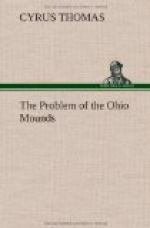The engraved shells also form a link which not only connects the mound-builders with historic times but corroborates the view advanced in regard to the Shawnees, and indicates also that the Cherokees were mound-builders. But before introducing this we will give the reasons for believing that the mounds of eastern Tennessee and western North Carolina are due to the last-named tribe.
CHAPTER IV.
The Cherokees as mound builders.
As the evidence on this point has to a large extent been presented in my article on “Burial Mounds of the Northern Section,” [Footnote: Fifth Ann. Rept. Bur Ethnol] also in articles published in the Magazine of American History [Footnote: May, 1884, pp. 396- 407] and in the American Naturalist, [Footnote: Vol. 18, 1884, pp. 232-240] it will be necessary here only to introduce a few additional items.
The iron implements which are alluded to in the above mentioned articles also in Science, [Footnote: Science, vol. 3, 1884, pp. 308-310] as found in a North Carolina mound, and which analysis shows were not meteoric, furnish conclusive evidence that the tumulus was built after the Europeans had reached America; and as it is shown in the same article that the Cherokees must have occupied the region from the time of its discovery up to its settlement by the whites it is more than probable they were the builders. A figure of one of the pieces is introduced here.
[Illustration with caption: Fig I Part of an iron blade from a North Carolina mound]
Additional and perhaps still stronger evidence, if stronger be needed, that the people of this tribe were the authors of most of the ancient works in western North Carolina and eastern Tennessee is to be found in certain discoveries made by the Bureau assistants in Monroe County, Tenn.
A careful exploration of the valley of the Little Tennessee River, from the point where it leaves the mountains to its confluence with the Holston, was made, and the various mound groups were located and surveyed. These were found to correspond down as far as the position of Fort London and even to the island below with the arrangement of the Cherokee “over-hill towns” as given by Timberlake in his map of the Cherokee country called “Over the Hills,” [Footnote: Memoirs, 1765] a group for each town, and in the only available spots the valley for this distance affords. As these mounds when explored yielded precisely the kind of ornaments and implements used by the Cherokees, it is reasonable to believe they built them.
Ramsey also gives a map, [Footnote: Annals of Tennessee, p. 376] but his list evidently refers to a date corresponding with the close of their occupancy of this section. Bartram [Footnote: Travels, pp. 373.374.] gives a more complete list applying to an earlier date. This evidently includes some on the Holston (his “Cherokee”) River and some on the Tellico plains. This corresponds precisely with the result of the explorations by the Bureau as will be seen when the report is published. Some three or four groups were discovered in the region of Tellico plains, and five or six on the Little Tennessee below Fort London and on the Holston near the junction, one large mound and a group being on the “Big Island” mentioned in Bartram’s list.




